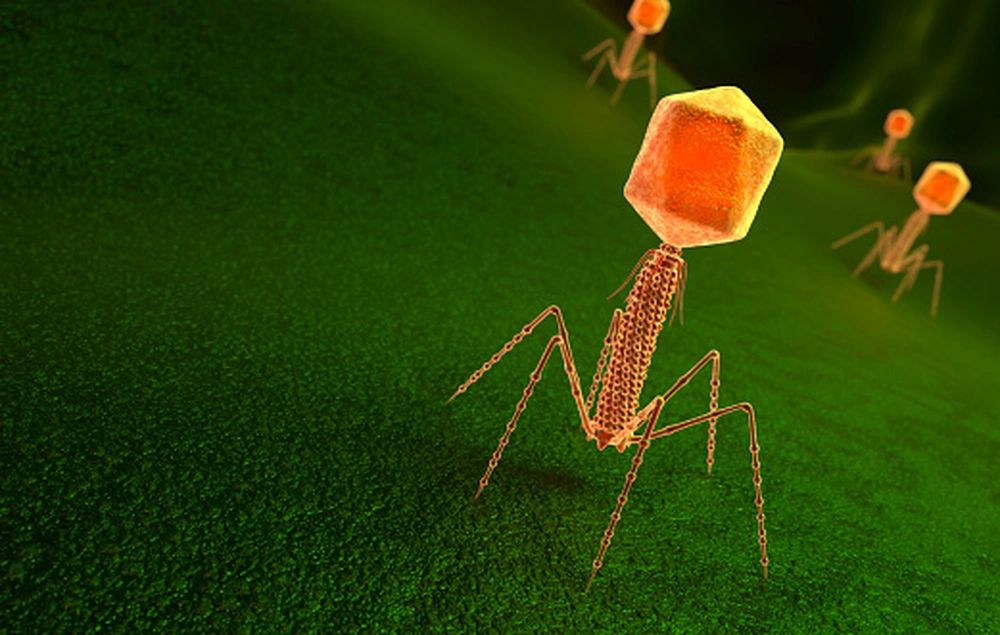
Written by Abby Olena for The Scientist
In 1977, scientists showed that a virus called S-2L that infects cyanobacteria has no adenine in its genome. Instead, S-2L uses a nucleotide known as diaminopurine or 2-aminoadenine, shortened to Z, that makes three hydrogen bonds—rather than the two that adenine (A) makes—when paired with thymine (T). In three papers published today (April 29) in Science, researchers show that the use of Z by phages, those viruses that infect bacteria, is more widespread than previously believed, and they describe the pathways by which the alternative nucleotide is made and incorporated into phage genomes.
“It’s been known that there’s this phage that doesn’t have adenine in its genome . . . and it’s been an unsolved mystery about how it does that,” says Jef Boeke, a molecular biologist at New York University Grossman School of Medicine who was not involved in the work. These papers “spell that out in glorious molecular detail,” he tells The Scientist. Plus, the authors “have done an amazingly comprehensive job of showing that this is not one crazy outlier, but there’s a whole group of bacteriophages that have this kind of genetic material.”
In 1998, Pierre Alexandre Kaminski of the Institut Pasteur and colleagues sequenced the genome of the S-2L cyanophage in hopes of deciphering the pathways that allow the virus to skirt the canonical nucleotide code. They found a sequence related to purA—the gene that encodes succinoadenylate synthase, one of the enzymes in the adenine synthesis pathway—that seemed like a good lead, but then shelved the project due to the challenges of working with the phage and its cyanobacterial host.
Over the following years, the researchers periodically searched databases and compared published sequences to the purA-like gene. In late 2015, they hit on a homologous sequence in Vibrio phage, which infects Vibrio, a genus of gram-negative bacteria that are much easier to work with than the S-2L cyanobacterial host. The sequence of the purA-like genes in the S-2L and Vibrio phages were more similar to each other than to other known purA genes, indicating that the Vibrio phage might also use diaminopurine in its DNA.
The team analyzed the composition of the Vibrio phage DNA and found that it does contain diaminopurine in place of adenine. They describe these findings in one of the papers out today, as well as the structure and in vitro function of the enzyme encoded by the purA-like gene, which they term PurZ. They show that PurZ has a similar function in the Z biosynthetic pathway to PurA in the synthesis of adenine, and that the bacteriophage genomes also contain another enzyme involved in making Z, known as PurB.
They also identify 19 purZ genes in different types of bacteriophages that phylogenetically cluster with the purA genes present in archaea.
“It’s striking how far back it goes . . . in the phylogeny,” says David Dunlap, a biophysicist at Emory University who did not participate in the work. “These things have been evolving in parallel for a long time. Since 1977, the cyanophage seemed like some sort of one-off problem and not very interesting, but they really made it apparent that this is out there, and in more places than we expect.”
In a second study, the same team identified phage genes encoding DNA polymerases that selectively incorporate diaminopurine in lieu of adenine. The original S-2L phage does not appear to harbor one of these genes, but nine other phage genomes, including Vibrio phage, do include a polymerase gene, which the authors named dpoZ. In the Vibrio phage and the other phage genomes, this DNA polymerase gene was found in the vicinity of the purZ gene.
An independent group, led by UIUC chemical and biomolecular engineering professor Huimin Zhao, who is also an affiliate faculty member in chemistry, corroborates these findings in the third study published today, while further characterizing the enzymes responsible for synthesizing Z and Z-containing genomes and identifying dozens of phage genomes distributed worldwide that contain genes encoding these enzymes. Zhao’s group also found a conserved enzyme encoded in several phage genomes that supports Z-genome synthesis by depleting adenosine triphosphate and its precursor from the nucleotide pool of the host, thus preventing the phages from incorporating A into their genomes.
In addition to using PurZ and PurB, these phages also hijack host enzymes to help synthesize diaminopurine and incorporate it into the phage genome. Finally, the researchers showed that Z-containing genomes are resistant to degradation by host restriction enzymes.
“If you want to be a diaminopurine-containing genome, you’re going to have to eliminate the competitor,” explains Dunlap. “The phage walks into an adenine world and has to enforce its will.”
Zhao and colleagues are looking into how to harness this show of phage will for applications such as treating bacterial infections. Researchers have already leveraged phages to treat some bacterial infections, he says, but including this pathway in those phages may make them even more effective, as they’d be resistant to degradation by their bacterial targets.
“There are a lot of questions that remain unanswered,” says Kaminski. In a paper that came out earlier this month on which he’s a coauthor, researchers shed light on one of those questions—how the S-2L genome is copied—by identifying the relevant polymerase. But Kaminski explains that one of the most difficult questions to answer will be when this mechanism evolved. “It’s supposed to be ancient because it roots deeply in the phylogenetic tree and because of the similarity of the [enzymatic] structures,” but it’s not clear whether Z or A genomes came first.
D. Sleiman et al., “A third purine biosynthetic pathway encoded by aminoadenine-based viral DNA genomes,” Science, doi:10.1126/science.abe6494, 2021.
V. Pezo et al., “Noncanonical DNA polymerization by aminoadenine-based siphoviruses,” Science, doi:10.1126/science.abe6542, 2021.
Y. Zhou et al., “A widespread pathway for substitution of adenine by diaminopurine in phage genomes,” Science, doi:10.1126/science.abe4882, 2021.